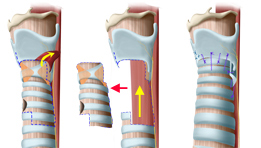Unimpeded breathing
Unimpeded breathing
A trauma or prolonged intubation can cause serious damage to a child's throat. To remedy this, our Unit has developed an internationally recognized technique.
Australia, Lapland, Argentina, Senegal, Morocco, Spain, France or Austria: our unit receives children from all around the world. Thanks to the expertise of Prof. Philippe Monnier, former Head of our Service, we have earned an international reputation in the treatment of stenosis (narrowing) of the larynx or the trachea, by surgery or endoscopic techniques such as laser.
An international reputation

The majority of our young patients have severe stenosis caused by scarring in and below the vocal cords. This complication can appear following a trauma or prolonged intubation. The organ affected is the larynx, which is very important, as it performs multiple roles in breathing, preventing food from entering the lungs, and producing sounds. To allow the child to breathe, a tracheotomy (opening of the trachea through the neck) may become necessary, but it entails many everyday difficulties, including the need for ongoing environmental monitoring to avoid the risk of asphyxiation if the tube becomes clogged or moves.
Cricotracheal resection
To solve this problem, our unit has specialized in the treatment of stenosis by resection. This technique was introduced for children in the late 1970s by Professors Marcel Savary and Philippe Monnier, and was then further developed by the latter. It involves cutting out the affected segment and reconstructing a tube formed of mucosa (mucous membrane) around a temporary prosthesis. Previously, the only possible intervention consisted of an enlargement plasty with cartilage grafts. "But,
due to recurrent stenosis, the success rate was just 35%", explains Prof. Monnier. "Resection immediately gave significantly better results, which later rose to a 90 % success rate."
Many children and parents have expressed their gratitude for being freed from the fears attached to tracheotomy. "I particularly remember a young girl from Mexico who was welcomed home on the tarmac at the airport by all those who had helped to finance her trip", says the specialist Prof. Monnier. "They were waiting with banners. There was a true atmosphere of joy!" He is still regularly invited to many countries to perform the procedure and to teach. Residential courses are also organized in our unit to train foreign surgeons.
Mastering all techniques
Our unit also receives children with airway obstruction due to congenital malformations. These are treated surgically or endoscopically. We also treat adults with lesions of the larynx following prolonged intubation, but also accidents, strokes or inhalation of smoke.
"Given the broad spectrum of pathological conditions and their complexity, we need to master all the available techniques," says Dr. Kishore Sandu, the current Head of our unit. But that is not all. "Each case is unique," he continues. "Children may also be premature or have heart or lung conditions in addition to the problem which concerns us directly. The doctors in charge must therefore have the experience that will enable them to choose the intervention best suited to the needs of each individual patient."



